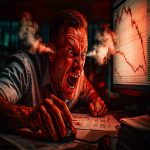Rage Trading Behaviour: Why Angry Investors Die First
Nov 24, 2025
Picture this: screens bleeding red, fingers twitching, breath shallow. The trader is no longer analysing; he is hunting ghosts. Every tick feels like betrayal, every candle a personal insult. He curses Powell, curses the market, curses himself, doubling his position like a drunk refilling the glass that poisoned him. The charts do not lie; they just watch him implode. This is rage trading, dopamine hijacked, testosterone surging, serotonin in free fall.
It begins as frustration and mutates into a ritual. Fight the tape, tweet the rage, reload the loss. He tells himself he is decisive, but he is only negotiating with chaos. The market never argues; it harvests emotion.
Seneca called anger brief insanity. In trading, it becomes expensive psychosis. The moment fury hits the bloodstream, logic dies, and reaction becomes religion. Calm traders are not saints; they are hunters who learned oxygen control. They slow their pulse while everyone else hyperventilates.
Diogenes would laugh at the spectacle, grown adults screaming at pixels.
Epictetus would whisper that you own nothing but your reaction.
Kahneman’s data would complete the eulogy, hot cognition compressing possibility into panic.
Rage traders do not die from the market.
They die from the mirror.
What Is Rage Trading Behaviour and Why It Feels Right
Rage trading is emotional engagement disguised as conviction. It is the trader who cannot let a headline pass without an opinion, cannot let a loss pass without revenge, cannot let the tape move without feeling targeted. The markers are blunt: overtrading, revenge entries after stops hit, ego-sized positions, broken stops, and FOMO buys justified by anger at being left behind.
It feels right because anger supplies energy. It mimics clarity. It feels like power. Kahneman’s research cuts through the illusion. The hotter the mind, the worse the decisions. Rage narrows the field of view. Cortisol floods the body, tightens vision, weakens the prefrontal cortex, where judgment lives, and boosts risk tolerance through fight-or-flight override. You think you are decisive. You are hijacked.
Diogenes would laugh at the theatre, investors shouting into the void, confusing volume with value and rage with resolve. The loudest usually lose the quietest.
The Psychological and Physiological Cost
Anger rewires behaviour in predictable and costly ways. Angry traders hold onto losers because their ego refuses to concede error. They panic-sell winners because fear crushes the plan. Time horizons shrink. Risk appetite spikes from desperation dressed as conviction. Seneca called it temporary insanity. Neuroscience calls it impaired executive function. Your profit-and-loss statement calls it a drain you cannot fund.
The body betrays strategy. Elevated cortisol narrows vision, spikes heart rate, and pushes glucose to the muscles for combat or escape. Helpful in running from a threat. Fatal when you need precision on a limit order. Discipline cannot survive an adrenaline storm. Your biology is tuned for survival in the wild, not survival in markets. Rage trading is an evolution turning against your capital.
How Markets Exploit Rage Trading Behaviour
Algorithms and headlines are engineered to provoke. Rage gets clicks. Clicks feed FOMO. FOMO kills discipline. Social platforms amplify outrage because outrage drives engagement, which in turn drives revenue. The first fifteen minutes after a Consumer Price Index print or Federal Reserve decision are an emotional slaughterhouse: spreads widen, depth thins, and your rage becomes someone else’s edge.
News algorithms spike price on headlines, bait stops, then reverse. Stop clusters gather at obvious levels—round numbers, prior day highs and lows—and market makers exploit this knowledge ruthlessly. If you’re trading angrily, you’re trading predictably. Epictetus’s lesson stands eternal: your reaction is the only variable you control. The market doesn’t care about your feelings—it prices them, then profits from them.
Historical Receipts: Rage’s Body Count
History offers no mercy to rage traders. In 1929, margin calls cascaded as panic selling fed more panic selling. Rage and fear merged into capitulation that destroyed fortunes. In 2008, the Lehman Brothers weekend fueled rage that led to Monday morning liquidations at the worst possible prices. Those who sold in anger regretted it within months.
Fast forward to 2021: meme stock euphoria peaked with “diamond hands” rage—collective anger at missing out drove parabolic tops in AMC and GameStop, followed by generational losses. In 2022, crypto rage liquidations demonstrated the cost of anger-fueled leverage meeting reality; billions evaporated in hours as over-leveraged traders refused to accept they were wrong until margin called their bluff.
In every cycle, rage trading behaviour kills accounts first. The survivors weren’t emotionless robots—they were disciplined humans who refused to let anger drive decisions.
Calm Isn’t Weak—It’s Tactical Precision
Absolute calm isn’t passivity or withdrawal. It’s measured response, detached timing, and systems overriding feelings. The best traders let setups come to them—they don’t chase breakouts, don’t yell at charts, and don’t need external validation. They see traps before stepping in because their vision isn’t clouded by cortisol.
Replace headline-driven rage with a five-dial state model: breadth (advancers versus decliners, up volume versus down volume), credit spreads (high-yield tone and direction), USD and real yields (pace and trajectory), volatility term structure (is the front month clenched or easing?), and leadership (who holds gains on red days?). Act only when three or more dials align in your favour. Otherwise, wait. Rage trading behaviour can’t survive in the presence of structure and discipline.
Field Manual: Rewire the Rage Loop
Breaking rage trading behaviour requires deliberate rewiring. Here’s the playbook:
90-second freeze rule: After any market shock or emotional spike, no orders until ninety seconds pass. Breathe. Read your five dials. Then decide. Ninety seconds feels like forever when adrenaline screams—that’s the point.
Execution windows: Limit order placement to two thirty-minute windows per day—mid-morning and mid-afternoon. All other hours are for study, strategy review, or silence. Shrink the opportunity for impulse.
Emotion log: Rate your emotional state on a scale of one to five before every trade. If you’re above three, no trade. Period. An emotion above 3 means you’re reacting, not strategising.
Attention diet: One price screen. One credit feed. One catalyst list. Mute all rage-bait sources—financial Twitter drama, sensationalist headlines, and talking heads designed to provoke. Attention is collateral. Guard it like cash.
Post-trade autopsy: After every trade, document the trigger, the state of your five dials, your emotional rating, and whether you’d repeat it. Add one rule to prevent one repeat error. Kill rage trading behavior one feedback loop at a time.
Small council: Recruit two to three trusted voices who can veto your worst ideas. If they say no, you listen. Ego hates this. Your account loves it.
Physiological reset: Before placing any order, execute box breathing—four counts in, four counts hold, four counts out, four counts hold. Drop your shoulders. Plant your feet. Your body signals to your brain that the threat has passed. Calm physiology enables calm decisions.
The Paradox Worth Stating
Rage feels like power, but is surrender. It feels like taking control, but you’ve handed control to the stimulus—the headline, the chart, the tweet. Calm feels passive, even weak. But calm is precision. It’s the sniper’s breath before the shot. Rage trading behaviour mistakes noise for signal and motion for progress. Calm investors know the difference.
Rage trading behaviour might feel powerful in the moment, but it’s a setup for destruction. The market doesn’t reward fire—it rewards clarity, patience, and discipline. Seneca knew it. Epictetus taught it. Kahneman proved it with data. Diogenes would mock those who refuse to learn it.
The loudest trader dies first. The calm one walks away with the capital. Trade to win, not to be vindicated. Rage engagement equals roadkill. Calm minds don’t just survive—they compound.
Rage trading behaviour destroys accounts: anger narrows judgment, breaks rules, feeds losses. Build calm, cut noise, trade with discipline—not emotion.













